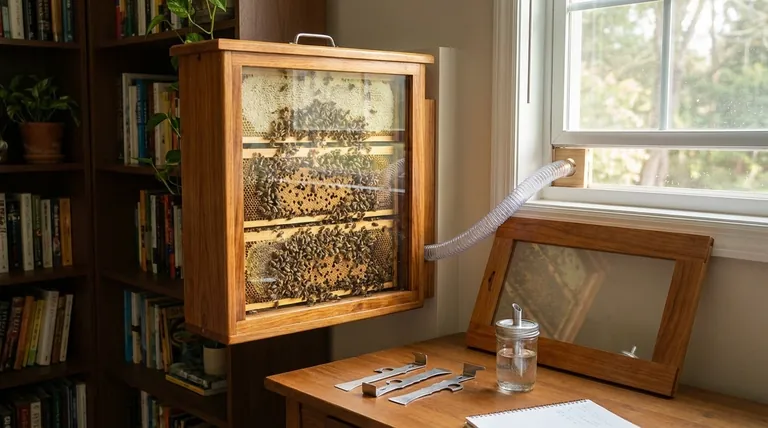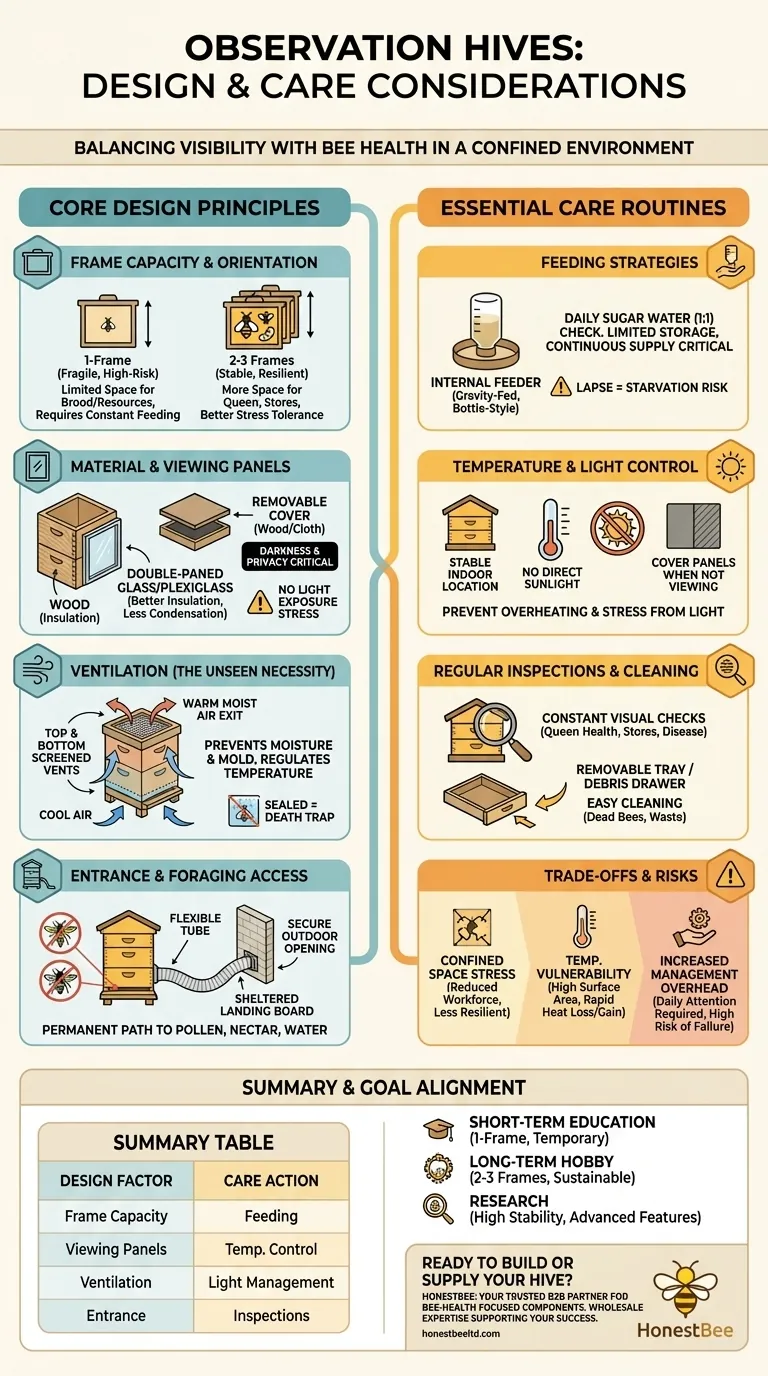Ultimately, a successful observation hive is a carefully engineered environment that prioritizes bee health above all else. The core design considerations involve frame capacity, material choice, effective ventilation, and reliable access to the outdoors. Care revolves around diligent feeding, strict temperature and light control, and regular maintenance to mitigate the inherent stresses of this unique enclosure.
The central challenge of an observation hive is balancing human visibility with the colony's biological needs. Unlike a standard hive, it has minimal insulation and storage space, making it an inherently fragile system that requires more active and precise management from the beekeeper to remain viable.

Core Design Principles for a Viable Hive
An observation hive is an artificial environment that must compensate for the natural advantages of a full-sized Langstroth hive. Your design choices are the foundation of the colony's success or failure.
Frame Capacity and Orientation
The number of frames dictates the hive's population potential and stability. Most designs use one to three standard Langstroth frames.
A single-frame hive offers maximum visibility of all activity but is extremely fragile. It has very little room for brood, pollen, and nectar, making it highly dependent on constant feeding and susceptible to collapse.
A multi-frame hive (two or three frames) provides more space for the queen to lay and for workers to store resources. This creates a more stable and resilient colony that can better withstand minor fluctuations in care.
Frames are typically arranged vertically to mimic how bees naturally build their comb, progressing from brood at the bottom to honey at the top.
Material and Viewing Panels
The hive body is typically constructed from wood, which provides some insulation and a familiar material for the bees.
The viewing panels are the hive's primary feature and are usually made of glass or high-quality plexiglass. Double-paned glass is superior as it provides better insulation, reducing condensation on the interior surface which can be fatal to bees.
It is critical to include removable covers (wood or heavy cloth) for the viewing panels. Bees require darkness and privacy for normal behavior, and constant exposure to light causes significant stress to the colony.
Ventilation: The Unseen Necessity
Proper ventilation is arguably the most critical design element. A sealed glass box creates a death trap from humidity and heat.
Ventilation prevents the buildup of excess moisture from the bees' respiration, which can lead to moldy comb and disease. It also allows the colony to regulate its internal temperature more effectively.
Effective designs incorporate screened vents at both the top and bottom of the hive. This allows for natural convection, with cool air entering from the bottom and warm, moist air exiting through the top.
Entrance and Foraging Access
The colony must have a clear and permanent path to the outside to forage for pollen, nectar, and water.
This is typically achieved with a flexible tube connecting the hive body to a small opening in a window or an exterior wall. The entrance must be secure to prevent pests like wasps or robber bees from gaining access.
The external opening should be protected from wind and rain. A small, sheltered landing board can aid the bees significantly.
Essential Care and Management Routines
An observation hive requires more frequent and hands-on management than a standard apiary hive. You are the primary regulator of its environment.
Feeding Strategies
Due to limited space for honey storage, consistent feeding is non-negotiable. The colony cannot store enough resources to survive for long without support.
An internal feeder is essential. Gravity-fed or bottle-style feeders are common, providing a continuous supply of 1:1 sugar water (one part sugar to one part water by weight).
Check the feeder levels daily or every other day. A lapse of even a day or two during a period of bad weather can lead to starvation.
Temperature and Light Control
Temperature is a major vulnerability. The hive lacks the thermal mass of a large colony and its woodenware.
Position the hive out of direct sunlight. Solar gain through the glass can rapidly overheat the hive and kill the brood and even adult bees. A cool, stable indoor location is ideal.
Always keep the viewing panels covered when you are not actively observing the colony. Light exposure is a major stressor that disrupts egg-laying, foraging, and overall social cohesion.
Regular Inspections and Cleaning
While you don't "crack open" an observation hive like a standard one, visual inspections are constant. Look for signs of a healthy queen (the presence of eggs and larvae), pollen stores, and any signs of disease or pests.
The bottom of the hive should be designed for easy cleaning. A removable tray or "debris drawer" allows you to clear out dead bees and waste without disturbing the colony.
Understanding the Trade-offs and Risks
Operating an observation hive means accepting certain inherent risks and limitations. Objectivity here is key to responsible beekeeping.
The Stress of a Confined Space
The small population and limited space mean the colony has a reduced workforce. It cannot perform all tasks (thermoregulation, defense, foraging) as efficiently as a full-sized colony. This makes it less resilient to challenges.
Vulnerability to Temperature Swings
The high surface-area-to-volume ratio means the hive loses and gains heat very quickly. It is entirely dependent on the ambient room temperature for stability, unlike a 50,000-bee colony that can generate its own heat.
Increased Management Overhead
You cannot be a passive beekeeper with an observation hive. It requires daily attention. Forgetting to refill the feeder or leaving it in a sunny spot can have rapid and fatal consequences for the colony.
Making the Right Choice for Your Goal
Select a design and commit to a care routine that aligns with your primary purpose for the hive.
- If your primary focus is short-term classroom education: A single-frame hive can be effective for a few weeks, but be prepared for it to be a temporary display requiring intensive support.
- If your primary focus is a long-term hobby or home display: A multi-frame (2-3 frame) hive is a much more stable and sustainable choice that better supports the colony's natural lifecycle.
- If your primary focus is research: Your design must prioritize stability with features like double-paned glass, integrated sensors, and highly reliable feeding and ventilation systems.
Your role is to provide a stable, low-stress environment that allows the colony's fascinating social structure to be revealed.
Summary Table:
| Design Consideration | Key Factor | Care Routine | Key Action |
|---|---|---|---|
| Frame Capacity | 1-3 Langstroth frames | Feeding | Daily sugar water check |
| Viewing Panels | Double-paned glass | Temperature Control | Keep out of direct sunlight |
| Ventilation | Top & bottom screened vents | Light Management | Cover panels when not in use |
| Entrance | Flexible tube to outdoors | Inspections | Regular visual checks for health |
Ready to build or supply your observation hive with confidence? HONESTBEE is your trusted partner for commercial apiaries and beekeeping equipment distributors. We supply durable, bee-health-focused hive components, feeders, and ventilation systems designed for optimal colony management. Let our wholesale expertise support your success—contact us today to discuss your specific needs!
Visual Guide

Related Products
- HONESTBEE Advanced Ergonomic Stainless Steel Hive Tool for Beekeeping
- Professional Dual-End Stainless Steel Hive Tool for Beekeeping
- Metal Bee Hive Stand Bee Box Stand for Beekeeping
- Professional 3-Bar Frame Grip with Integrated Hive Tool
- Professional Engraved Round Hive Number Tags for Beekeeping
People Also Ask
- What tools are used for cleaning frames? A Beekeeper's Simple 4-Tool Guide
- What are the basic tools for beekeeping? Essential Starter Kit for Safe & Successful Hive Management
- Why do hive tools have a hole? Unlock the Secret to Efficient Beekeeping
- What is the hole in a hive tool for? A Multi-Tool for Apiary Repairs and Maintenance
- What are some common uses of a hive tool? Essential Multi-Purpose Tool for Every Beekeeper



















